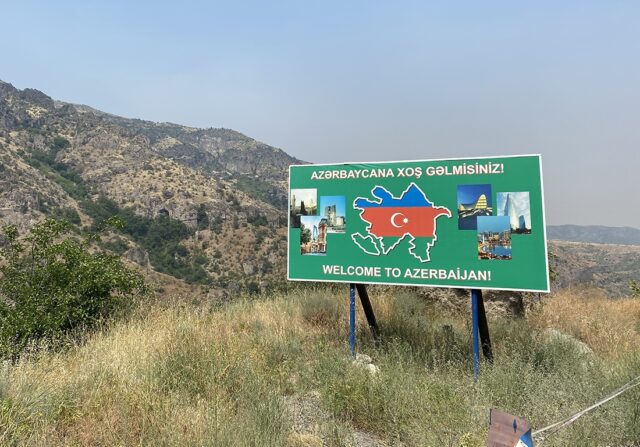
Azerbaijan Calls for Return of Contested Villages
Publication: Eurasia Daily Monitor Volume: 21 Issue: 59
By:

Executive Summary:
- Azerbaijan is increasing the pressure on Armenia to return eight border settlements— four villages and four exclaves—under Baku’s sovereignty.
- Azerbaijani officials and the expert community have repeatedly demanded the return of the four border villages, voicing optimism that the issue can be solved in a matter of weeks.
- Whether the process will happen relatively peacefully with the withdrawal of the Armenian forces or require the use of military force remains an open question.
The standoff continues between Armenia and Azerbaijan over several border villages, and Baku seems determined to restore sovereignty over them soon. Both societies have reacted emphatically to the issue. The government acknowledges Azerbaijan’s legal ownership over the settlements in Armenia, though the opposition and many ordinary citizens are critical of this stance (see EDM, April 8). In Azerbaijan, the public mood is uncompromising and optimistic. The four villages in question—Baghanis Ayrim (Bağanıs Ayrım), Ashagi Askipara (Aşağı Əskipara), Kheyrimli (Xeyrımlı), and Gizilhajili (Qızılhacılı)—are part of the eight Azerbaijani villages outside Karabakh that are currently under Armenian control. The mentioned settlements are situated along the Armenian-Azerbaijani border and attached to mainland Azerbaijan, while the other four are exclaves. Baku believes the status of the four villages can be determined relatively quickly, but solving the exclave issue will likely be more complicated. The lack of a properly delimited and demarcated border has hampered the resolution of territorial disputes and peace negotiations.
The Azerbaijani population of the border villages was exiled in 1990. At the beginning of the Second Karabakh War, some Azerbaijani individuals still residing in the area were reportedly burned alive (Azlogos, May 22, 2021). The villages, now mostly in ruins due to systematic looting, became a more prominent issue following the end of that conflict (Top-Center, April 2; Commonspace, April 3).
Over the past few months, Baku has been particularly vocal about these four villages and repeatedly demanded their return. In October 2023, Azerbaijani President Ilham Aliyev brought up the eight villages “under Armenian occupation and stressed the importance of liberating these villages from occupation” during a phone conversation with European Council President Charles Michel (President.az, October 7, 2023). A few months later, in January, Aliyev again raised this issue and asserted that the four non-exclave villages should be unconditionally returned to Azerbaijan. He also referred to the importance of the Armenian and Azerbaijani border commissions’ work on the delimitation of their shared border in resolving the matter (President.az, January 10). Around that same time, Azerbaijan’s public television station recorded an exclusive video report on these settlements, seeking to cultivate more national discourse on the subject (Ictimai TV, January 21).
Some officials have pushed more hawkish rhetoric. Several Azerbaijani members of parliament, including Fazail Aghamali, Elman Nasirov, and Arzu Nagiyev, as well as military experts, predict or threaten the use of military force unless the discussed villages are again placed under Baku’s sovereignty (Yeni Musavat, March 5; Modern.az, March 6; Bizim media, March 13; Oxu.az, March 26)
The overall consensus in Azerbaijan holds that the fate of the four border villages will be easy to resolve, with many expecting their return in the coming weeks. A compilation of short interviews from the residents of Gazakh conducted by Radio Free Europe/Radio Liberty’s Azerbaijani service in March and other sources demonstrate a sense of optimism and, in some cases, certainty that these settlements will soon be returned to Azerbaijan (Azadliq Radiosu, March 26; Modern.az, March 29).
Whether the process will happen peacefully with the withdrawal of Armenian forces or require the use of military force remains an open question. Armenian Prime Minister Nikol Pashinyan has hinted that Armenia might return control of the four border villages to Azerbaijan in a unilateral handover of territory (OC Media, March 19). During a visit to the northern Tavush province, Pashinyan declared that the return of the villages to Azerbaijan could prevent war. The Armenian premier’s statements were met with some controversy, with former Defense Minister Seyran Ohanyan warning that such a handover would advance Azerbaijani positions (Azatutyun, March 19). Ohanyan has additionally called on the Armenian military to disobey Pashinyan’s orders to withdraw from the disputed border areas (Azatutyun, March 24).
Unless the situation is carefully managed, this territorial standoff could easily escalate into an armed confrontation (Commonspace, April 3). Even if a blitz operation is carried out to reclaim the settlements, the fragile normalization process between Azerbaijan and Armenia will undoubtedly be damaged. The international community’s reaction is also worth considering. Some Western countries have voiced their discontent with Azerbaijan’s restoration of sovereignty over Karabakh and the exodus of the Armenian population from the area. These same states have reacted harshly to Baku’s efforts to remedy the border situation. Azerbaijani officials and experts, nevertheless, believe that they are favored by international law in keeping the de-occupied lands unless the conflict spills over into Armenia proper (Modern.az, March 29).
Determining the status of the exclave settlements will likely be a more complicated problem. In the same January interview, Aliyev proposed setting up a separate expert group to deal with the exclave issue (President.az, January 10). Yet, critical obstacles remain, including other territorial disputes and stalled peace negotiations. Given the complexity of the issues between Armenia and Azerbaijan, the delimitation and demarcation of the 1,000-kilometer border may take years, if not decades.



